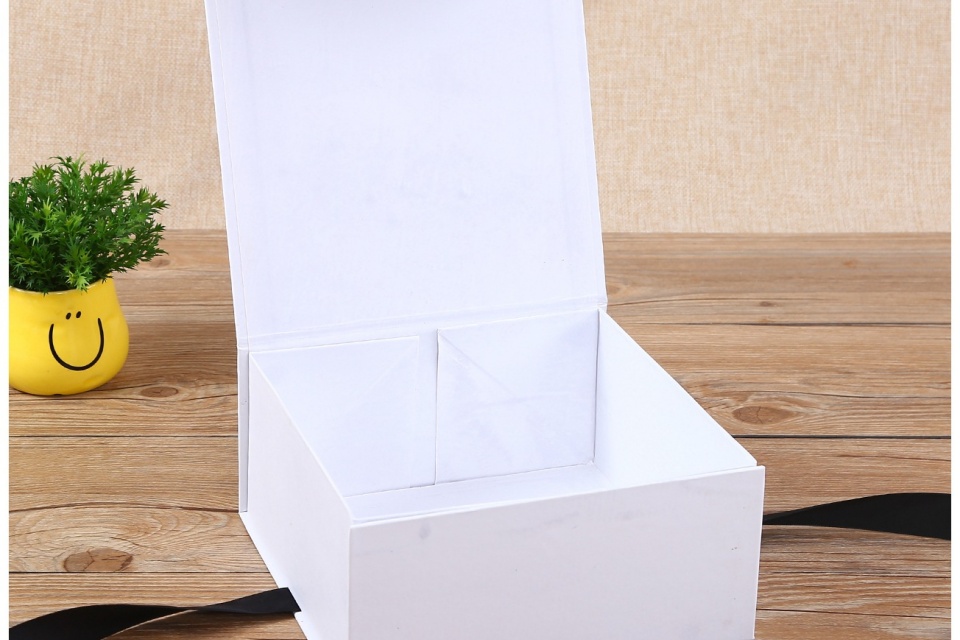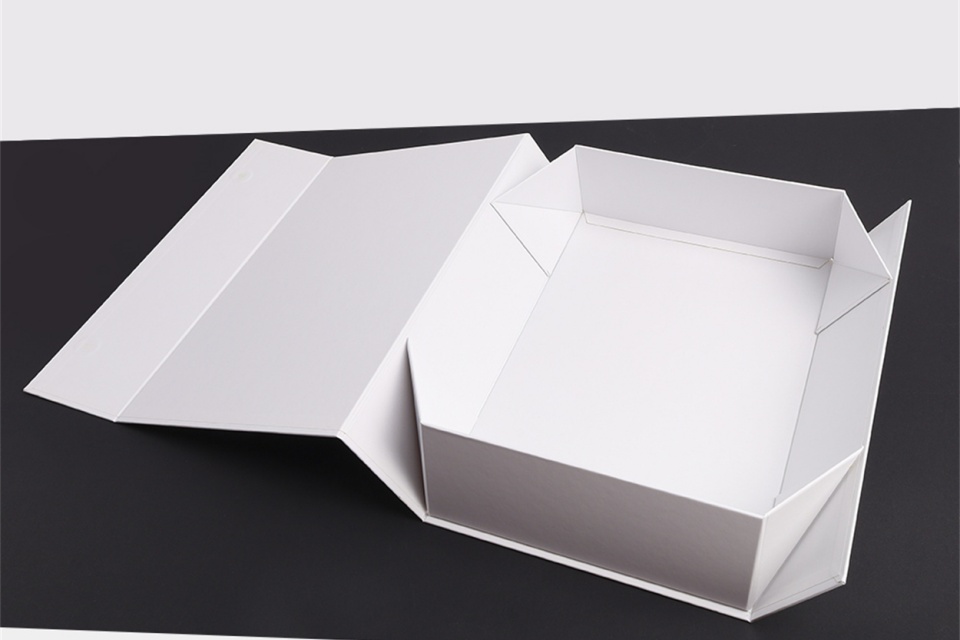Industry News
What Are Collapsible (Foldable) Gift Boxes And How Do They Work
What Are Collapsible (Foldable) Gift Boxes And How Do They Work
Collapsible foldable gift boxes, often referred to as foldable rigid boxes, are innovative packaging solutions designed to combine aesthetic appeal with practicality. These boxes can be easily assembled and disassembled, allowing for efficient storage and transport while maintaining a premium appearance. Their unique design leverages advanced folding mechanisms and material selections to cater to a variety of consumer needs, making them particularly popular in the retail and e-commerce sectors.
The design of collapsible gift boxes focuses not only on visual and tactile qualities but also on sustainability. Many brands opt for eco-friendly materials, such as recycled paper and other sustainable options, in response to growing consumer demand for environmentally responsible practices. Customization is another significant feature, enabling brands to create distinctive identities through unique shapes, colors, and embellishments, which enhance the overall unboxing experience.
However, collapsible gift boxes are not without their controversies and challenges. Critics point out that their structural vulnerability may lead to damage during transportation compared to traditional rigid boxes, which are often perceived as more luxurious. Additionally, the initial costs associated with high-quality materials and advanced printing technologies may deter smaller brands from adopting this packaging solution, posing a barrier to broader market penetration. Despite these drawbacks, the advantages of collapsible gift boxes, such as cost efficiency, space optimization, and their ability to enhance customer experience, have solidified their place as a favored choice in contemporary packaging design.
Design
Structural Design Innovations
Collapsible foldable gift boxes are engineered with innovative structural designs that prioritize both aesthetics and functionality. The design incorporates advanced folding mechanics and material selection to ensure that the boxes are easy to assemble while maintaining a sturdy and premium appearance when in use. This structural adaptability allows for various configurations, catering to different packaging needs without compromising on visual appeal.
Materials and Sustainability
A wide range of materials can be used in the production of collapsible gift boxes, including Kraft paper, textured paper, and recycled alternatives. The choice of materials not only impacts the visual and tactile qualities of the packaging but also its environmental sustainability. Brands are increasingly opting for recyclable and eco-friendly materials to align with consumer expectations for environmentally responsible practices. Furthermore, the use of sustainable production practices enhances the overall value proposition of the packaging, distinguishing brands in a competitive market.
Customization Capabilities
Customization options are a significant feature of collapsible gift box design. Brands can leverage design elements such as unique shapes, colors, and surface treatments to create a distinctive identity that resonates with their target audience. Advanced printing technologies and surface enhancement techniques, such as UV coating and embossing, allow for a high level of personalization, enabling brands to craft memorable unboxing experiences that foster a connection with consumers.
Aesthetic Trends and User Experience
In addition to functionality, the aesthetic trends in collapsible gift box design reflect a growing emphasis on minimalism and sophisticated simplicity. This approach not only enhances visual appeal but also engages consumers on an emotional level. Elements such as sensory stimulation through custom scents and audio components can elevate the unboxing experience, making it more memorable. The strategic use of shapes can also convey brand values and create emotional connections, further enriching the user's interaction with the product.
Mechanism
Collapsible foldable gift boxes utilize a series of innovative design and engineering principles to achieve functionality, ease of assembly, and structural integrity. The core of their mechanism revolves around the folding design, which allows these boxes to be assembled quickly and stored compactly when not in use.
Folding Mechanisms
The folding mechanism is engineered to facilitate smooth assembly and secure closure. Various configurations can be employed, including butterfly folds, parallel collapses, or diagonal folds, each tailored to specific design requirements and user needs. Advanced crease patterns are implemented to control the folding behavior, ensuring that folds occur at predetermined locations and angles, thereby preventing unwanted distortions during assembly.
Scoring and Gluing Techniques
Scoring plays a crucial role in the functionality of collapsible boxes, as it affects both the visual appeal and structural integrity of the final product. The mathematical relationship between scoring depth, material thickness, and fold radius is meticulously calculated to ensure clean folds and durability over multiple assembly cycles. For instance, magnetic closure boxes require precise scoring to align closure points perfectly, as even minor deviations can compromise the box's functionality. The assembly process incorporates strategic gluing patterns that secure specific panels while allowing others to move freely along established fold lines. This is achieved through specialized gluing equipment that applies precise amounts of adhesive, ensuring strong bonds where necessary while maintaining clean fold lines elsewhere. The methodical sequence of assembly ensures that each adhesive bond has adequate setting time, resulting in collapsible boxes that not only perform well but also have a polished exterior finish.
Structural Reinforcement
To enhance the longevity and utility of collapsible gift boxes, structural reinforcements are integrated into the design. These reinforcements can include additional layers of material at critical stress points, ensuring that the boxes can withstand repeated use and handling without compromising their form or functionality. The careful selection of materials that maintain color vibrancy and resist cracking at fold points further contributes to the overall durability and aesthetic appeal of the boxes.
Assembly and Logistics
The assembly of collapsible rigid boxes is designed to be straightforward and efficient, typically taking less than 30 seconds per unit without the need for specialized tools. This allows brands to implement just-in-time assembly strategies, optimizing workflow and adapting to fluctuating demand patterns. With a production timeline of 15-20 days for custom orders, collapsible boxes offer not only a premium packaging solution but also an effective logistics answer to modern supply chain challenges.
Types
Collapsible foldable gift boxes, often referred to as foldable rigid boxes, are designed to combine elegance with practicality. These boxes come in various types, each serving specific purposes and preferences.
-
Standard Collapsible Boxes Standard collapsible boxes are a popular choice for their blend of style and functionality. They resemble traditional rigid packaging but can be easily folded flat for storage when not in use. This type of box is commonly used for premium products, including jewelry, cosmetics, and gourmet foods, allowing brands to present their items attractively while minimizing storage space.
-
Rigid Gift Boxes Rigid gift boxes are another common variant, made with sturdy materials like chipboard and kraft paper. These boxes typically feature a top and bottom lid design, which can be fully or partially covered. Rigid gift boxes are often decorated with ribbons or custom inserts, making them suitable for special occasions such as birthdays and corporate gifting. They provide a memorable unboxing experience, appealing to consumers looking for remarkable packaging.
-
Cylinder Kraft Gift Boxes Cylinder kraft gift boxes offer a unique cylindrical shape, enhancing their visual appeal. These boxes are crafted from kraft paper and can be used for a variety of gifts, making them a stylish option for consumers who want something different from the traditional box shapes.
-
Customizable Folding Boxes Customizable folding boxes are designed to cater to specific brand needs. They can be manufactured in various sizes, colors, and materials, allowing businesses to tailor their packaging to reflect their brand identity. This flexibility is beneficial for industries such as cosmetics, electronics, and food packaging, where presentation is key.
-
Eco-friendly Options In response to the growing demand for sustainable packaging, eco-friendly collapsible boxes are becoming increasingly popular. Made from recyclable materials, these boxes not only reduce environmental impact but also attract eco-conscious consumers. The compact structure of these boxes minimizes transportation volume, further supporting green initiatives.
Advantages
Collapsible foldable gift boxes offer a range of advantages that make them increasingly popular across various industries, particularly in packaging, logistics, and retail.
Environmental Sustainability Advantages
One of the primary benefits of collapsible gift boxes is their alignment with environmental sustainability. By utilizing responsible packaging choices, brands can appeal to eco-conscious consumers, which has proven to enhance customer acquisition and retention rates. The use of sustainable materials and designs not only reduces environmental impact but also strengthens brand loyalty through shared values with consumers.
Cost Efficiency and Space Optimization
Collapsible boxes provide significant cost savings across the supply chain. Their design allows for efficient storage and transportation, as they can be folded flat when not in use, minimizing storage space and reducing shipping costs. This hybrid approach combines the luxury appearance of rigid packaging with the logistical advantages of folding cartons, allowing brands to benefit from both aesthetics and practicality.
Enhanced Marketing and Customer Experience
The unboxing experience is a crucial aspect of customer engagement, and collapsible gift boxes excel in this area. Their innovative designs create memorable unboxing moments that encourage social media sharing and promote brand visibility. Additionally, brands can offer customizable features, such as unique shapes and insert styles, which further enhance the presentation and protection of products.
Versatility and Industry-Specific Applications
The versatility of collapsible gift boxes allows them to cater to various industries, from food and beverage to pharmaceuticals and retail. Their design can accommodate different insert styles, such as molded pulp trays and foam inserts, enhancing product protection while appealing to consumers' aesthetic preferences. Furthermore, advancements in production technology enable manufacturers to produce boxes in a range of shapes, including hexagonal and circular, to meet diverse market needs.
Economic Impact Analysis
The economic benefits of adopting collapsible gift boxes are notable, including reduced damage rates due to superior protection compared to traditional folding cartons. This results in lower returns processing costs and improved logistics efficiency. Additionally, manufacturers offer financial flexibility through various payment terms and compensation conditions, ensuring brands can navigate quality issues effectively while maximizing their return on investment.
Disadvantages
While collapsible gift boxes offer numerous advantages, they are not without their drawbacks.
Structural Vulnerability
One notable disadvantage is their structural vulnerability during transportation and handling. Although premium manufacturers implement reinforcement techniques to enhance durability, the collapsible design inherently means that the boxes can be more susceptible to damage compared to their rigid counterparts. Each fold and junction point may represent a potential failure location, which, if not adequately reinforced, could lead to compromised integrity and functionality over time.
Perceived Value
Additionally, consumer perception can also impact the desirability of collapsible gift boxes. In some markets, traditional rigid boxes are seen as more premium and luxurious. The aesthetic appeal of a fully assembled rigid box may outweigh that of a collapsible option, especially in high-end gifting scenarios where the presentation is crucial. As a result, brands may find it challenging to communicate the value proposition of collapsible boxes when competing against more traditional packaging solutions.
Limited Customization Options
Another disadvantage lies in the limitations of customization. While collapsible gift boxes can be tailored to a degree, their design constraints may restrict the extent of creative branding opportunities compared to fully rigid boxes. This can be a disadvantage for brands looking to make a strong visual impact through complex designs or unique structural features.
Cost Implications
Lastly, the cost implications associated with producing collapsible boxes can also be a concern. Although they can reduce shipping and storage costs due to their space-saving design, the initial investment in high-quality materials and advanced printing techniques may deter smaller brands or those with limited budgets from adopting this packaging solution.
Applications
Industry-Specific Applications and Customization
Collapsible gift boxes have found a versatile range of applications across various industries, catering to both retail and corporate needs. Their customizable designs enable businesses to adapt packaging to specific products and market demands, enhancing their appeal to consumers. In the luxury retail sector, collapsible boxes serve as premium packaging solutions that elevate the unboxing experience, aligning with the growing consumer preference for sustainable and aesthetically pleasing options. Furthermore, these boxes can be tailored to reflect brand identity and values, providing an opportunity for companies to showcase their commitment to sustainability through eco-friendly materials and designs.
Consumer Experience Enhancement Through Innovative Packaging
The rising trend of e-commerce has significantly influenced packaging strategies, particularly with collapsible gift boxes playing a central role in enhancing consumer experiences. These boxes are not only practical, allowing for easy transport and storage, but they also contribute to an engaging unboxing experience that fosters brand loyalty. As online retail continues to grow, the significance of efficient and visually appealing packaging cannot be overstated; collapsible boxes can help businesses improve customer satisfaction by offering functionality alongside style.
Retail Ready Solutions for Multiple Sectors
In brick-and-mortar retail, collapsible gift boxes facilitate improved customer experience and store efficiency. Retailers can leverage these boxes to streamline operations, as they provide a convenient means for customers to carry their purchases, especially during promotions or bulk purchases. This feature is particularly beneficial in environments where space is limited, allowing for efficient storage and reduced waste from single-use bags. Additionally, the adaptability of collapsible boxes makes them suitable for a wide range of products, from luxury items to everyday gifts, thereby catering to diverse market segments.
Cultural Influences in Packaging Design
Cultural considerations also play a significant role in the design and application of collapsible gift boxes. As businesses increasingly operate in global markets, recognizing cultural preferences in packaging design can ensure that products resonate with diverse audiences. By integrating elements that reflect local customs and traditions, brands can enhance the appeal of their packaging and strengthen their connection with customers, ultimately driving sales and brand loyalty.
Manufacturing Process
Production Optimization and Quality Control
Recent advancements in technology have revolutionized the manufacturing of collapsible rigid boxes, resulting in improved production efficiency and consistent quality control. Automated manufacturing processes, including visual positioning technology, enable precise component alignment during assembly, thereby reducing variability associated with manual methods. This technological integration allows manufacturers such as Fetching Printing to significantly shorten delivery times to a standard window of 15-20 days, a notable enhancement compared to traditional manufacturing timelines. Quality assurance protocols play a critical role in the production process. These protocols involve multiple inspection points, starting from raw material certification to die-cutting accuracy verification and structural integrity testing. Each box undergoes rigorous folding cycle testing to ensure it can withstand repeated assembly and disassembly without losing structural integrity. The implementation of ISO9001-2015 Quality Management Systems further standardizes quality control processes, providing a framework for continuous improvement.
Assembly and Gluing Processes
The assembly and gluing processes are integral to the overall manufacturing of collapsible gift boxes. Each box is subjected to various testing phases to confirm both its rigid characteristics and its ability to collapse properly. This includes repeated assembly and disassembly cycles, compression testing, and dimensional verification in both assembled and collapsed states. The utilization of advanced die-cutting technology ensures the creation of ultra-precise components, contributing to the boxes' structural integrity and ease of assembly.
Quality Control and Testing Protocols
Quality control measures are crucial in ensuring that collapsible rigid boxes perform effectively throughout their lifecycle. Each production batch undergoes a sampling inspection process, where boxes are tested through multiple assembly, collapse, and reassembly cycles to ensure consistent performance. Additionally, humidity resistance is verified, recognizing that material moisture content can impact folding performance over time. This comprehensive testing regimen ensures that the boxes not only maintain their premium appearance but also function reliably within the supply chain from manufacturer to consumer.
Concept Development and Prototyping
The manufacturing process also involves an essential concept development phase, where client visions are translated into tangible designs. This stage includes brainstorming sessions to align design creativity with client expectations and market needs. Prototyping techniques, such as 3D printing and CAD modeling, allow for the rapid creation of detailed prototypes, facilitating testing and iteration while reducing production time and costs. The combination of innovative design approaches and the adaptability of existing machinery ensures that complex designs can be realized efficiently, ultimately enhancing both creativity and practicality in packaging solutions.
Categories
Latest News
Contact Us
Contact: Aaron Lee
Phone: +8613570866244
Tel: +8675529490260
Add: Li Songlang 2nd Industrial Zone,No.18,FengTang Rd,Guangming New District


